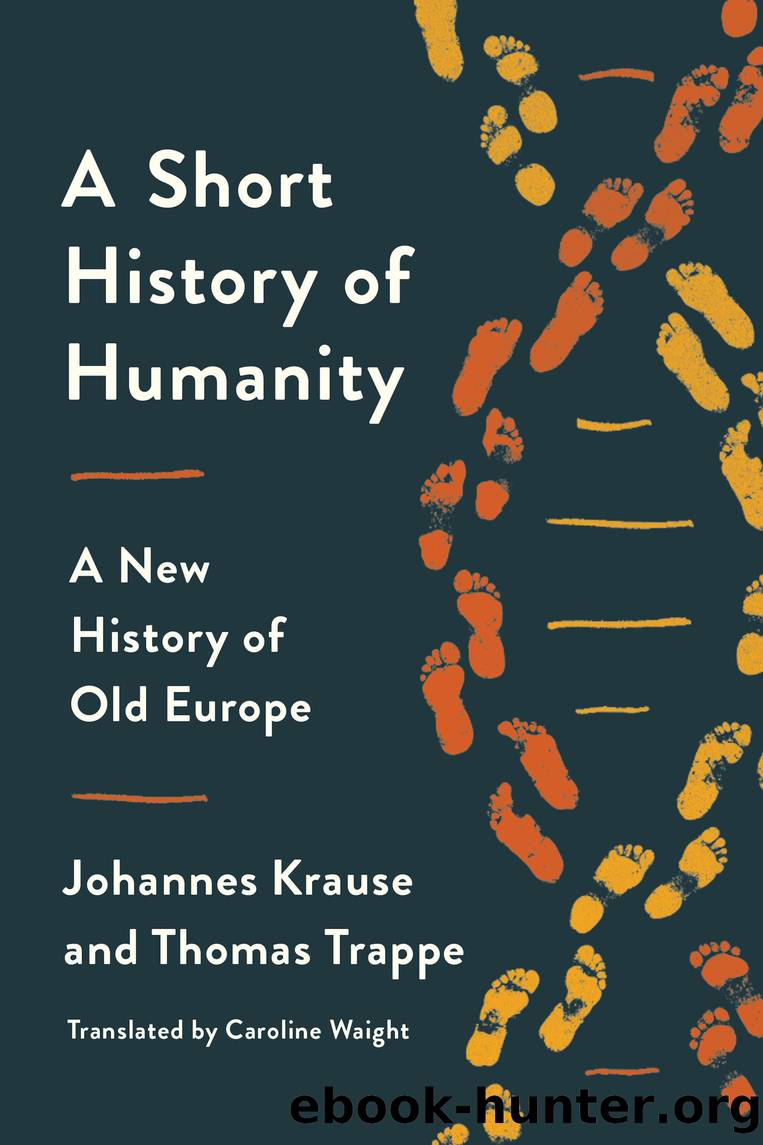A Short History of Humanity by Johannes Krause & Thomas Trappe

Author:Johannes Krause & Thomas Trappe [Krause, Johannes & Trappe, Thomas]
Language: eng
Format: epub
Publisher: Random House Publishing Group
Published: 2021-04-13T00:00:00+00:00
INVENTING THE PATRIARCHY
From approximately 2200 BCE the Bell Beaker and Corded Ware cultures fused into the Unetice culture, concentrated mostly in central Germany, which left the famous bronze Nebra sky disk to posterity. The shores of the Lech, a river near Augsburg in southern Germany, was another place where those two cultures lived in close proximity, though each had its own settlements, customs, burial rites, and probably languages. They developed into another early Bronze Age culture during the same period as the Unetice culture, in this region around the Lech River. Itâs likely that their way of life resembled that of other Central European societies at the time. People lived on farms that mostly consisted of a house, an outbuilding, and a stall for animals and buried their dead in cemeteries nearby. The DNA preserved in these graves has survived to the present day, roughly 4,000 years later, offering glimpses into their living conditions and social organization.
We examined the DNA of almost 100 people buried in the Lech settlements who died between 2500 and 1500 BCE, during the transition into the Bronze Age. We sequenced their genomes and performed a strontium isotope analysis on their teeth. This analysis takes advantage of a simple principle: different forms of strontium can be absorbed into the human skeleton through dietâin other words, through eating plants and animals. These isotopes have different masses and are found in different relative concentrations according to geographical area. Because human beings during this period obtained their food solely from local sources, the relative concentration can tell us where they grew up. Certain parts of the skeletonâfor example, the enamel of the molarsâdevelop during childhood and absorb strontium, so we can also find out whether a person spent their whole life in a specific place or lived a more mobile existence. The process doesnât work on modern-day humans, because the majority of our food is sourced from places far beyond our immediate environment.
We carried out a strontium isotope analysis on eighty-three people buried near the Lech: twenty-six men, twenty-eight women, and the rest children. One might have expected to see a similar ratio of locals to newcomers in adults of both sexes. Yet this was not the case. Seventeen of the women (almost two-thirds) and only one man came from elsewhere sometime in late adolescence. This clear disparity in the ratio of male to female arrivals could not be dismissed as coincidence. It looked like evidence of a deliberate process of exchange between regions. If the settlements we examined are in fact typical of the early Bronze Age, then this hints at an entirely new relationship between the sexes. While the men remained in their settlements, the women they married often came from elsewhere; this suggests that likely a hierarchy had emerged, with men at the top. Many wives were outsiders, and must likewise have often sent their own daughters away when they reached marriageable age.
Nonetheless, the burial sites do not indicate discrimination against women. As both parents, mothers and fathers received the same number of grave goods.
Download
This site does not store any files on its server. We only index and link to content provided by other sites. Please contact the content providers to delete copyright contents if any and email us, we'll remove relevant links or contents immediately.
QED: The Strange Theory of Light and Matter (Princeton Science Library) by Richard P. Feynman(300)
Science Book by Unknown(298)
The Best American Science and Nature Writing 2020 by Michio Kaku(291)
Weird, Wild, Amazing! by Tim Flannery(251)
Science Is Not What You Think: How It Has Changed, Why We Cant Trust It, How It Can Be Fixed by Henry H. Bauer(239)
Einstein's Physics for the Lay Person: How Einstein Revolutionized Our Understanding Of The Universe by Madeleine Santos(238)
The Best American Science and Nature Writing 2011: The Best American Series by Mary Roach & Tim Folger(194)
The Science of Conjecture by James Franklin(180)
The Best American Science and Nature Writing 2021 by Ed Yong(151)
